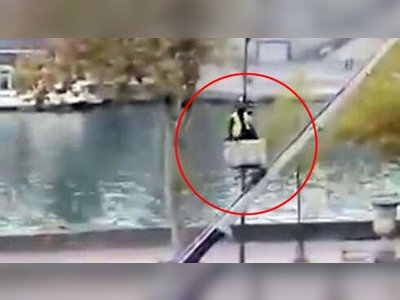Copper Thieves Force Removal of Iconic 'De Tong' Sculpture
Persistent thefts lead to the dismantling of Rudi van de Wint's renowned artwork between Almere and Lelystad, with its future now uncertain.
De Tong, the striking landscape sculpture designed by renowned artist Rudi van de Wint, no longer stands along the A6 highway between Almere and Lelystad in the Netherlands.
The conspicuous nine-meter-high structure, which had been a feature of the flat Flevoland terrain since 1993, was dismantled and removed to curb the issue of persistent copper theft.
The decision to dismantle De Tong follows months of increasingly brazen thefts, with thieves having stripped away significant portions of the copper adorning the artwork.
The most recent and severe act of vandalism occurred in October, when the lower half of the sculpture was left bare, and more copper disappeared just last month.
These incidents compelled provincial authorities to take decisive action, as previously disclosed earlier this month.
Visible from the motorway yet situated in a secluded location, De Tong has been a target for thieves for years.
The sculpture's isolated setting on the Knardijk makes it vulnerable, as the lack of surveillance facilitates these criminal acts.
In an effort to protect the remaining copper-clad sections from further plundering, the decision was made to carefully remove and store the sculpture.
Dubbed 'The Tongue of Lucifer' at first, a name that drew controversy and ultimately prompted a rechristening in 2020, De Tong has long stood as a symbol of both artistic and environmental harmony.
Created from a fusion of steel and copper wire, the sculpture has faced threats from those seeking to profit from its materials, particularly copper, which fetches a substantial price on the scrap market.
The current removal of the sculpture is not the first instance where it has faced vandalism.
Notably, in 2006, it suffered significant damage at the hands of metal thieves, a hit that required four years and nearly a quarter of a million euros to restore.
In 2012, it was again subject to theft and vandalism, as lighting fixtures and electrical boxes were dismantled and destroyed.
The provincial government, with updates provided by Omroep Flevoland, has announced that the sculpture will remain in storage until at least the beginning of next year.
At that time, officials are expected to elucidate plans regarding its future and potential restoration.
De Tong's fate hangs in the balance, emblematic of the broader, persistent challenge that cultural monuments face in the face of vandalism and theft.
It remains to be seen whether this storied work will find a safe and permanent home in the years to come.
The conspicuous nine-meter-high structure, which had been a feature of the flat Flevoland terrain since 1993, was dismantled and removed to curb the issue of persistent copper theft.
The decision to dismantle De Tong follows months of increasingly brazen thefts, with thieves having stripped away significant portions of the copper adorning the artwork.
The most recent and severe act of vandalism occurred in October, when the lower half of the sculpture was left bare, and more copper disappeared just last month.
These incidents compelled provincial authorities to take decisive action, as previously disclosed earlier this month.
Visible from the motorway yet situated in a secluded location, De Tong has been a target for thieves for years.
The sculpture's isolated setting on the Knardijk makes it vulnerable, as the lack of surveillance facilitates these criminal acts.
In an effort to protect the remaining copper-clad sections from further plundering, the decision was made to carefully remove and store the sculpture.
Dubbed 'The Tongue of Lucifer' at first, a name that drew controversy and ultimately prompted a rechristening in 2020, De Tong has long stood as a symbol of both artistic and environmental harmony.
Created from a fusion of steel and copper wire, the sculpture has faced threats from those seeking to profit from its materials, particularly copper, which fetches a substantial price on the scrap market.
The current removal of the sculpture is not the first instance where it has faced vandalism.
Notably, in 2006, it suffered significant damage at the hands of metal thieves, a hit that required four years and nearly a quarter of a million euros to restore.
In 2012, it was again subject to theft and vandalism, as lighting fixtures and electrical boxes were dismantled and destroyed.
The provincial government, with updates provided by Omroep Flevoland, has announced that the sculpture will remain in storage until at least the beginning of next year.
At that time, officials are expected to elucidate plans regarding its future and potential restoration.
De Tong's fate hangs in the balance, emblematic of the broader, persistent challenge that cultural monuments face in the face of vandalism and theft.
It remains to be seen whether this storied work will find a safe and permanent home in the years to come.











